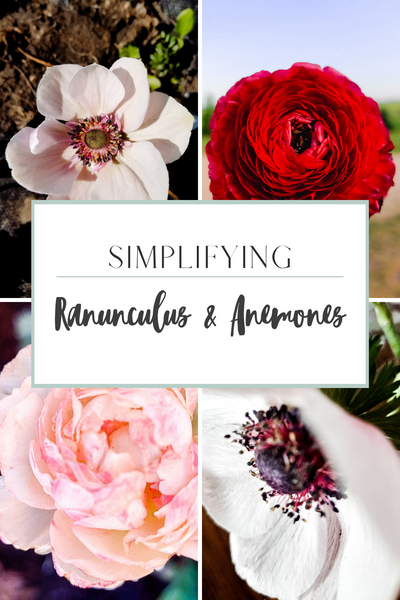Discover three ways to simplify growing anemones and ranunculus
1. Soaking your Corms
This is the first step, and a very important step for success! I soak my corms in cottage cheese containers (classy, I know) for three to four hours. Many experienced growers will hook up an aerator to keep the water fresh. I do not use an aerator but do change out the water every half hour. I have had great success without the aerator, but I am not soaking tens of thousands of corms at a time, perhaps that makes a difference. The aerator is not necessary, in my experience, but will never hurt to use if you have one!
Very important: do not soak your corms for much longer than the four hours. If corms are sitting in water for too long they will definitely rot. After four hours they should be nice and plump and ready to plant.
2. Pre-sprout
In our climate we must pre-sprout these corms. They take about 90 days to bloom but prefer cool temperatures. Here in Saskatchewan we don't have the luxury of 90 - 120 days of spring weather! Lucky for us though, pre-sprouting corms is a super simple process.
Once I've soaked my corms I plant, in trays, the ranunculus with the ‘fingers’ pointing down, and anemones with the ‘pointy ends’ down. They like to wake up to a dark, cool environment so I shove mine under the step in the garage. The temperature fluctuates between 10 °C, and 15 °C. Make sure the soil is damp, but never wet. I check on them after a week just to make sure the soil hasn't dried out. About 10 - 14 days after I plant them I move the trays to a window sill, or a shelf with a grow light. They will continue to grow in this cool environment until they are ready to be planted out in the garden.
3. When and How to Transplant
Once the ground is warm and easy to work in the spring it is safe to transplant your pre-sprouted corms. Usually by this stage they are somewhat established plants. I generally transplant ranunculus and anemones out between five and six weeks before the last frost date. The soil temperature in your garden is more important than the ‘weeks before last frost date’. Soil temperature needs to be at least 10°C before you transplant. I use a digital meat thermometer to keep track of my soil temperature in the spring.
The air temperatures are still quite cool overnight so I always cover these transplants with frost cloth until all chance of overnight frost has passed. They are able to handle frost but do best when they are protected a bit at this stage.
Disclaimer
This post contains affiliate links, which means, if you purchase something, I earn a small commission at no extra cost to you.

